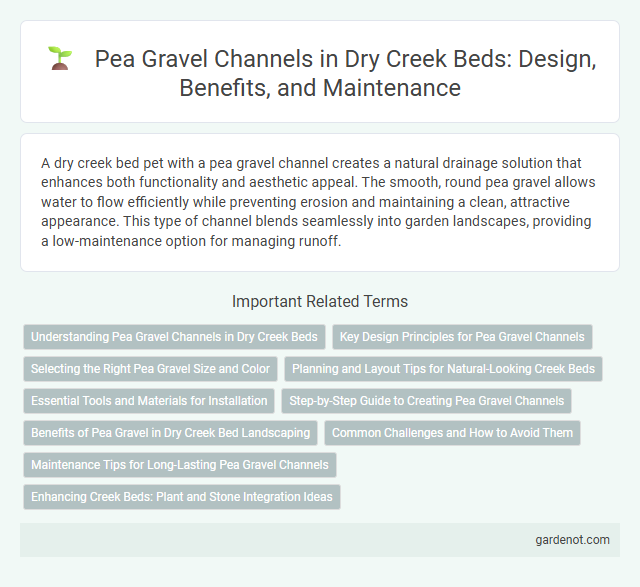A dry creek bed pet with a pea gravel channel creates a natural drainage solution that enhances both functionality and aesthetic appeal. The smooth, round pea gravel allows water to flow efficiently while preventing erosion and maintaining a clean, attractive appearance. This type of channel blends seamlessly into garden landscapes, providing a low-maintenance option for managing runoff.
Understanding Pea Gravel Channels in Dry Creek Beds
Pea gravel channels in dry creek beds serve as effective drainage solutions, facilitating water flow while preventing soil erosion. Their rounded, small-sized stones create porous pathways that enhance water infiltration and reduce sediment accumulation. These channels also support natural habitats by allowing moisture retention and promoting biodiversity in arid landscapes.
Key Design Principles for Pea Gravel Channels
Pea gravel channels rely on proper slope design and adequate drainage to prevent erosion and promote efficient water flow. The use of uniformly sized pea gravel between 1/8 and 3/8 inches enhances permeability and reduces sediment buildup, ensuring long-term channel stability. Incorporating geotextile fabric beneath the gravel layer prevents soil intrusion while maintaining natural water infiltration rates.
Selecting the Right Pea Gravel Size and Color
Choosing the appropriate pea gravel size for a dry creek bed channel is essential for optimal water flow and erosion control, typically favoring 1/8 to 3/8 inch sizes for balanced drainage and stability. Color selection should complement the surrounding landscape, with natural earth tones like tan, gray, and buff enhancing aesthetic appeal while blending seamlessly with native plants and stone features. Properly sized and colored pea gravel not only improves functionality but also elevates the visual harmony of the dry creek bed environment.
Planning and Layout Tips for Natural-Looking Creek Beds
For a natural-looking dry creek bed with a pea gravel channel, start by mapping out a meandering path that mimics a real watercourse, ensuring gradual curves and varying widths to enhance visual interest. Incorporate native plants and larger rocks strategically along the edges to create depth and prevent gravel displacement, while maintaining a balanced mix of sizes in the pea gravel for authentic textural variation. Use landscape fabric underneath the gravel to inhibit weed growth and improve drainage, ensuring the dry creek bed remains low-maintenance and functional in all weather conditions.
Essential Tools and Materials for Installation
Installation of a pea gravel channel in a dry creek bed requires essential tools such as a shovel, landscape fabric, and a tamper to ensure proper base preparation and compaction. Key materials include high-quality pea gravel, typically 3/8-inch to 1/2-inch in size, and geotextile fabric to prevent weed growth and maintain drainage. Precise grading tools and edging materials also optimize water flow control and maintain the channel's shape over time.
Step-by-Step Guide to Creating Pea Gravel Channels
Creating a pea gravel channel begins by outlining the desired path and excavating the area to a depth of 4 to 6 inches. A landscape fabric layer is then installed to prevent weed growth and soil erosion, followed by adding a base layer of crushed stone for stability and drainage. Finally, pea gravel is spread evenly on top, compacted, and smoothed to create an attractive and functional dry creek bed channel.
Benefits of Pea Gravel in Dry Creek Bed Landscaping
Pea gravel provides excellent drainage in dry creek bed landscaping, preventing water accumulation and soil erosion. Its smooth, rounded texture enhances aesthetic appeal while minimizing weed growth by restricting sunlight to soil. The durability and low maintenance of pea gravel make it a cost-effective solution for long-lasting dry creek bed designs.
Common Challenges and How to Avoid Them
Pea gravel channels in dry creek beds often face drainage issues due to compaction and sediment buildup, reducing water flow efficiency. To avoid clogging, regularly inspect and remove debris, while ensuring proper grading and installing a geotextile fabric beneath the gravel to maintain permeability. Selecting the right pea gravel size and depth helps prevent displacement and erosion, ensuring long-term stability and functionality.
Maintenance Tips for Long-Lasting Pea Gravel Channels
Regularly raking and replenishing pea gravel prevents compaction and maintains effective drainage in dry creek bed channels. Installing landscape fabric beneath the gravel reduces weed growth and soil displacement, enhancing channel longevity. Routine inspections after heavy rain ensure debris removal and preserve the structural integrity of the pea gravel channel.
Enhancing Creek Beds: Plant and Stone Integration Ideas
Integrate pea gravel channels within dry creek beds to improve drainage and create a natural, aesthetically pleasing flow path while reducing soil erosion. Combine various native plants such as ornamental grasses and drought-resistant shrubs alongside smooth pea gravel to enhance texture contrast and promote biodiversity. Strategic placement of stones and plants not only stabilizes the creek bed but also supports local wildlife habitats and minimizes water runoff impact.
Pea gravel channel Infographic

 gardenot.com
gardenot.com